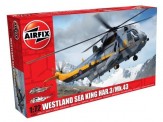Airfix: Junkers JU87B-2/R-2 in 1:48 [1507115]
Although usually associated with the Wehrmacht's feared 'Lightning War' attacks at the beginning of WWII, the Ju87B Stuka was also a highly effective maritime strike bomber. Capable of performing precision dive bombing attacks against any Allied vessel, the Stuka took a heavy toll of shipping in the English Channel, North Africa and in the Mediterranean. The Stuka also saw service with the air forces of Italy, Romania, Bulgaria and Hungary, as well as remaining in Luftwaffe service throughout WWII.
The attack dive of the Stuka was so severe, that quite a number of automatic features had to be incorporated into the manoeuvre. At an altitude of approximately 15,000 ft., the pilot would locate his target through a bombsight window, which was located in the floor of the cockpit. His engine and propeller had automatic controls, to optimise the aircraft when in a dive, and an automatic trimmer would make the aircraft tail heavy, as the pilot initiated the dive. He would move the dive lever to the rear, which would limit the 'kick' of the control column and quickly begin a defined sequence of actions, which if done correctly, would see his ordnance detonate on his intended target. He quickly set the trim tabs, reduced the throttle and closed the engine coolant flaps. The aircraft would automatically become tail heavy and pitch over in a 180-degree roll, placing the aircraft in a steep nose-down dive - at the same time, dive breaks were automatically deployed, to reduce the speed of the dive, to a constant 360 mph. This was the point of no return - the attack sequence had begun......................
Although usually associated with the Wehrmacht's feared 'Lightning War' attacks at the beginning of WWII, the Ju87B Stuka was also a highly effective maritime strike bomber. Capable of performing precision dive bombing attacks against any Allied vessel, the Stuka took a heavy toll of shipping in the English Channel, North Africa and in the Mediterranean. The Stuka also saw service with the air forces of Italy, Romania, Bulgaria and Hungary, as well as remaining in Luftwaffe service throughout WWII.
The attack dive of the Stuka was so severe, that quite a number of automatic features had to be incorporated into the manoeuvre. At an altitude of approximately 15,000 ft., the pilot would locate his target through a bombsight window, which was located in the floor of the cockpit. His engine and propeller had automatic controls, to optimise the aircraft when in a dive, and an automatic trimmer would make the aircraft tail heavy, as the pilot initiated the dive. He would move the dive lever to the rear, which would limit the 'kick' of the control column and quickly begin a defined sequence of actions, which if done correctly, would see his ordnance detonate on his intended target. He quickly set the trim tabs, reduced the throttle and closed the engine coolant flaps. The aircraft would automatically become tail heavy and pitch over in a 180-degree roll, placing the aircraft in a steep nose-down dive - at the same time, dive breaks were automatically deployed, to reduce the speed of the dive, to a constant 360 mph. This was the point of no return - the attack sequence had begun......................
Empfohlen für Modellbauer und Sammler ab 14 Jahren. Aufgrund maßstabs- und vorbildgerechter bzw. funktionsbedingter Gestaltung sind Spitzen, Kanten und Kleinteile vorhanden. Verschluckungsgefahr. Deshalb nicht in die Hände von Kindern unter 10 Jahren!
Hersteller-Informationen
- Hersteller
- Airfix
- Website
- https://uk.airfix.com
- Kontaktformular
- Kontaktformular






